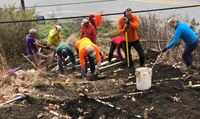Creating A Safer, More Enjoyable Rachel Carson Trail Experience
By Mark Eyerman
We’ve had great success over the past few years moving the Rachel Carson Trail (RCT) off of roads and building new trail in the woods. During the project, which began in the fall of 2019, we’ve eliminated about 2.5 miles of road trail and added approximately 4 miles of new trail. The primary goal of the initiative has been the safety of our trail users, but a side benefit is that it’s allowed us to build high-quality trails that are more pleasant to use.
The signature feature of the RCT has traditionally been a trail utilizing power/pipeline right-of-ways that go straight up a hill and straight down the other side, most often in direct sunlight and waist-high weeds. While this enabled a contiguous trail to be established in an urban environment, it may not always have been the best trail from an aesthetic or a maintenance standpoint. So when planning to move the trail off of the roads, we endeavored to create both an enjoyable trail to use and one that is practical to maintain.
Deep woods afford trail users a cool, shaded environment and the tree canopy keeps ground vegetation to a minimum. With that in mind, whenever possible we tried to build the new sections of the trails in deep woods. We also tried to run the trail near interesting and historic features to enhance the trail experience. This is exemplified by the spectacular river vista seen on ‘the shelf’ section in the Murray Hill area.
From a philosophical standpoint, the best trail experience is when you can travel along the trail with your head up, looking around and taking in all the natural beauty around you. The goal is to build trails where you don’t have to constantly look down to follow the trail and avoid obstacles. That’s why our team worked to build trails that are ‘relatively’ straight, flat and even. Given the terrain here in Western Pennsylvania, that was quite a challenge, but it was a guiding principle of our work. A straight trail is easy to follow and lets you look far ahead. When the trail avoids constant ups and downs and minimizes undulations (generally level), less attention is needed for your footfalls. An even trail -- one with a wide treadway that is free of roots, rocks and obstructions -- is another way to free trail users from the need to constantly watch each step. It isn’t always possible to build trails that are straight, flat and even in this area, but we certainly make the attempt where we can.
Adhering to all of these aesthetic and philosophical criteria as we build out a trail is predicated upon gaining permission from the various landowners where the trail travels. This is another factor that can constrain our trail-building efforts.
As you can see, moving the trail off of the road and into the woods is a complex challenge with many factors to consider. In a best-case scenario the process takes a year; from landowner negotiations to thorough scouting of an area to determine the options, deciding upon the final trail route and finally construction. It takes us hundreds of hours of work (500 or more) for each mile of new trail that we build. None of this work is possible without a large group of volunteers dedicated to making it a reality.
We’ve done a great job over the past few years making the RCT safer and more enjoyable, and plans are already under way to continue this effort. We are always eager to welcome more help. Consider volunteering to help with planning, landowner negotiations, land acquisition, scouting or trail construction. Join the team and help us continue to improve the RCT for the enjoyment of all.
